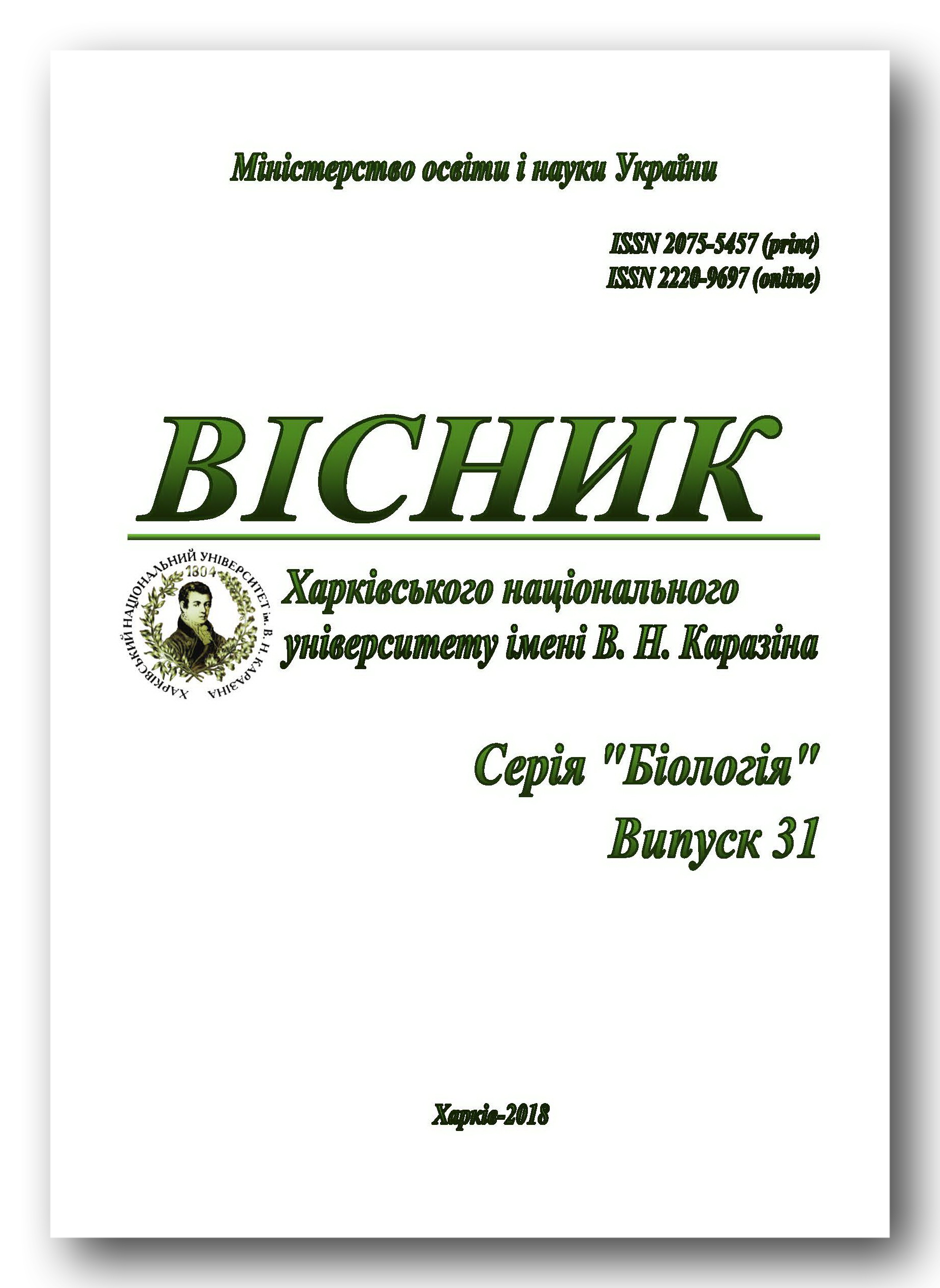Biological characteristics, feeding and structure of tunnels of the greater mole-rat (Spalax microphthalmus) in the area of the regional landscape park “Velikoburlutskyi Steppe”
Abstract
New data on the greater mole-rat’s biology in the territory of the Regional landscape park «Velikoburlutskyi steppe” (Kharkiv region, Ukraine) concerning nutrition, burrow structure and social structure are presented. The greater mole-rat has only one litter consisting of 1–3 pups during the year. Contrary to the prevailing general opinion that mole-rats lead solitary way of life we have found cohabitation of a female, a male and their young of the current year at three of the seven areas of our study. Young mole-rats settle in a new place at the end of June – early July. They can be found above ground often at this time. In the greater mole-rat population from the Regional Park “Velikoburlutskyi steppe” males are characterized by the body length of 220–260 mm, by hind foot length of 27–30 mm, by the body weight of 219–520 g. For adult females the average body length is 200–250 mm, the hind foot length is about 26–30 mm, the body weight ranges from 284 to 409.6 g. Many greater mole-rat specimens on the forehead or occiput have an individual light spot (yellowish-white) or a white longitudinal strip by which we can identify individuals at repeated catching. Eating the underground parts of plants, the mole-rat makes very long tunnels conducting by them horizontally and closely to the surface and throwing along them the large piles of soil (up to 0.5 m in diameter). Soil emissions marking feeding tunnels had a base diameter of up to 50–60 cm. In the nest part of the hole the number of habitable chambers and chambers for stocks can be up to 10, and they are located at the depth of 3.5 m. Digging activity of the mole-rat grows in late March – early April and in the autumn at the end of September – early October. We have repeatedly noted the appearance of emissions in the winter during the thaw. Mole-rats harm the agriculture with their digging activity (damage cultivated areas, digging under the plants and so on); in addition, mole-rats sometimes directly eat potato tubers, onion and other root vegetables. The total weight of one mole-rat stock can reach 16 kg. In one of burrows excavated by us near the vegetable gardens of locals in Nesterivka village of Velikoburlukskyi district in Kharkiv region we found 8 kg of potatoes, 4 kg of carrots, 3 kg of greater burdock roots, 0.6 kg of couch grass roots.
Downloads
References
Dukelskaya N.M. The mole-rat biology and testing of different ways to control them // Plant Protection Proceedings. – 1932. – Vol. 4, issue 2. – P. 23-46. (in Russian)
Migulin А.А. Animals of URSR. – Kiev: Рublishing House of the Academy of Sciences of URSR, 1938. –Р.312. (in Ukrainian)
Ognev S.I. Animals of the USSR and adjacent countries. Vol. 5. – Moscow-Leningrad: Publishing House of the Academy of Sciences of the USSR, 1947. – P. 558–641. (in Russian)
Ovchinnikova S.L. The distribution of a greater mole-rat (Spalax microptbalmus Guld.) in the south-east part of Central Black Earth Region // Proceedings of Voronezh University. – 1971. – Issue 93. – P. 80–83. (in Russian)
Ovchinnikova S.L. The features of the individual life of a greater mole-rat Spalax microptbalmus Guld. in the conditions of Central Black Earth Region // Some problems of biology and soil science. – Voronezh, 1969. – P. 54–57. (in Russian)
Ovchinnikova S.L. The greater mole-rat (Spalax microphtalmus Guld.) in the south-east part of Central Black Earth Region (ecology, biological bases of control). Thesis of Candidate of Science in biology. –Voronezh, 1971a. – 17p. (in Russian)
Puzachenko A.Yu. Intrapopulation variability of the greater mole-rat Spalax microphtalmus (Spalacidae, Rodentia) skull. 1. Methods of data analysis. Non-age variability of males // Zoology Journal. – 2001. – Vol. 80, issue 3. – P. 1–15. (in Russian)
Puzachenko A.Yu., Vlasov A.A. The digging activity of greater mole-rat Spalax microphtalmus Guld (Spalacidae, Rodentia) // Zoology Journal. – 1993. – Vol. 72, issue 11. – P. 91–103. (in Russian)
Topachevsky V.A. Mole rats // Fauna of the USSR. Mammals. Vol. 3, no. 3. – Leningrad: Nauka, 1969. – P. 1–248. (in Russian)
Tsytsulina K., Formozov N., Zagorodnyuk I., Sheftel B. Spalax microphthalmus // IUCN Red List of Threatened Species. Version 2011.2. – International Union for Conservation of Nature, 2008.
Vinogradov B.S., Gromov I.M. Rodents fauna of the USSR. – Moscow-Leningrad: Publishing House of the Academy of Sciences of the USSR, 1952. – P. 175–177. (in Russian)
Authors retain copyright of their work and grant the journal the right of its first publication under the terms of the Creative Commons Attribution License 4.0 International (CC BY 4.0), that allows others to share the work with an acknowledgement of the work's authorship.




